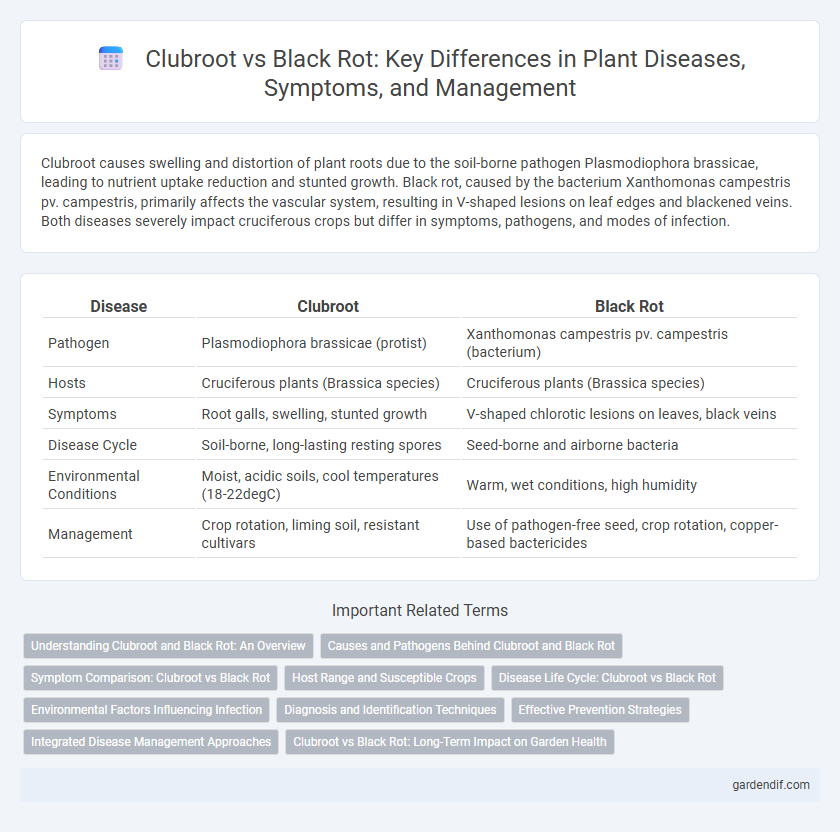
Clubroot vs Black rot Illustration
Clubroot causes swelling and distortion of plant roots due to the soil-borne pathogen Plasmodiophora brassicae, leading to nutrient uptake reduction and stunted growth. Black rot, caused by the bacterium Xanthomonas campestris pv. campestris, primarily affects the vascular system, resulting in V-shaped lesions on leaf edges and blackened veins. Both diseases severely impact cruciferous crops but differ in symptoms, pathogens, and modes of infection.
Table of Comparison
| Disease | Clubroot | Black Rot |
|---|---|---|
| Pathogen | Plasmodiophora brassicae (protist) | Xanthomonas campestris pv. campestris (bacterium) |
| Hosts | Cruciferous plants (Brassica species) | Cruciferous plants (Brassica species) |
| Symptoms | Root galls, swelling, stunted growth | V-shaped chlorotic lesions on leaves, black veins |
| Disease Cycle | Soil-borne, long-lasting resting spores | Seed-borne and airborne bacteria |
| Environmental Conditions | Moist, acidic soils, cool temperatures (18-22degC) | Warm, wet conditions, high humidity |
| Management | Crop rotation, liming soil, resistant cultivars | Use of pathogen-free seed, crop rotation, copper-based bactericides |
Understanding Clubroot and Black Rot: An Overview
Clubroot, caused by the pathogen Plasmodiophora brassicae, is a soil-borne disease that primarily affects cruciferous plants, leading to swollen and deformed roots, reduced nutrient uptake, and stunted growth. Black rot, caused by the bacterium Xanthomonas campestris pv. campestris, targets crucifers by infecting vascular tissues, producing characteristic V-shaped lesions on leaves and resulting in wilting and severe yield loss. Both diseases significantly impact Brassica crop productivity, necessitating accurate identification and integrated management strategies to mitigate economic damage.
Causes and Pathogens Behind Clubroot and Black Rot
Clubroot is caused by the soil-borne pathogen Plasmodiophora brassicae, which infects the roots of cruciferous plants, leading to gall formation and nutrient uptake disruption. Black rot is caused by the bacterium Xanthomonas campestris pv. campestris, which enters through leaf wounds and causes V-shaped chlorotic lesions and blackening of veins in brassicas. Both diseases significantly impact crop health, but their distinct pathogens and infection mechanisms require targeted management strategies.
Symptom Comparison: Clubroot vs Black Rot
Clubroot causes swollen, distorted roots and stunted plant growth, primarily affecting cruciferous crops, while black rot is characterized by V-shaped yellow to brown lesions on leaf margins that progress inward, often accompanied by blackened veins. Clubroot symptoms lead to root galls, impairing nutrient uptake, whereas black rot symptoms predominantly involve foliar damage and vascular discoloration. Both diseases significantly reduce crop yields but differ distinctly in their symptom manifestation and plant tissue affected.
Host Range and Susceptible Crops
Clubroot primarily affects cruciferous crops such as cabbage, broccoli, cauliflower, and kale, caused by the soil-borne pathogen Plasmodiophora brassicae. Black rot targets a broader range within the Brassicaceae family, including cabbage, mustard, radish, and turnip, caused by the bacterium Xanthomonas campestris pv. campestris. Both diseases result in significant yield losses in cruciferous vegetables but differ in pathogen type and specific crop susceptibility.
Disease Life Cycle: Clubroot vs Black Rot
Clubroot, caused by the soilborne pathogen *Plasmodiophora brassicae*, undergoes a life cycle that includes resting spores surviving up to 20 years in soil, germinating in the presence of host root exudates to infect brassica roots and causing characteristic gall formations. Black rot, caused by the bacterium *Xanthomonas campestris* pv. *campestris*, follows a life cycle involving seedborne transmission, survival in plant debris, and entry through hydathodes or wounds, leading to vascular tissue colonization and blackening of veins. The persistence of clubroot spores in soil contrasts with black rot's reliance on infected seeds and plant material for disease spread and establishment.
Environmental Factors Influencing Infection
Clubroot, caused by Plasmodiophora brassicae, thrives in acidic soils with poor drainage and cooler temperatures between 18-25degC, creating favorable conditions for spore germination and root infection. Black rot, caused by Xanthomonas campestris pv. campestris, is favored by warm, humid environments with temperatures of 24-29degC and frequent leaf wetness, which facilitate bacterial entry through hydathodes and wounds. Soil pH, moisture levels, and temperature are critical environmental factors that distinctly influence the prevalence and severity of these diseases in cruciferous crops.
Diagnosis and Identification Techniques
Clubroot diagnosis relies on inspecting root galls caused by the pathogen Plasmodiophora brassicae, often confirmed through PCR assays detecting its specific DNA. Black rot identification involves observing characteristic V-shaped chlorosis on leaves and blackened veins, with bacterial culture and PCR tests targeting Xanthomonas campestris pv. campestris validating the infection. Advanced molecular techniques like qPCR enhance sensitivity and specificity in differentiating these crucial brassica diseases.
Effective Prevention Strategies
Effective prevention of clubroot centers on soil pH management, maintaining levels above 7.2 by liming to inhibit Plasmodiophora brassicae spores. Crop rotation with non-host species for at least four years reduces soil-borne inoculum, limiting disease incidence. For black rot caused by Xanthomonas campestris pv. campestris, using certified disease-free seeds and implementing strict sanitation protocols in irrigation and tools minimize pathogen spread.
Integrated Disease Management Approaches
Integrated disease management for clubroot in cruciferous crops focuses on crop rotation, resistant cultivars, and soil liming to raise pH and reduce pathogen viability. Black rot management emphasizes the use of certified disease-free seeds, crop residue removal, and copper-based fungicides to suppress Xanthomonas campestris pv. campestris. Combining cultural practices, chemical treatments, and resistant varieties optimizes control efficacy against both soil-borne clubroot and seed-borne black rot in brassica production.
Clubroot vs Black Rot: Long-Term Impact on Garden Health
Clubroot, caused by the soilborne pathogen Plasmodiophora brassicae, leads to swollen and distorted roots in cruciferous plants, resulting in reduced nutrient uptake and long-term soil contamination. Black rot, caused by the bacterium Xanthomonas campestris pv. campestris, primarily affects foliage and vascular tissues, causing leaf chlorosis, necrosis, and significant yield loss, but is less persistent in soil compared to Clubroot. The long-term impact of Clubroot on garden health is more severe due to its ability to remain viable in soil for up to 20 years, whereas Black rot outbreaks can be managed with crop rotation and sanitation practices.
Clubroot vs Black rot Infographic

 gardendif.com
gardendif.com